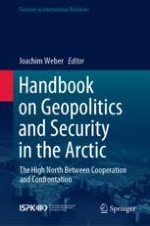
2020 | OriginalPaper | Chapter
A Two-Faced Russia? Civilian Interests and Great Power Politics in the High North
Author : Jørgen Staun
Published in: Handbook on Geopolitics and Security in the Arctic
Publisher: Springer International Publishing
Activate our intelligent search to find suitable subject content or patents.
Select sections of text to find matching patents with Artificial Intelligence. powered by
Select sections of text to find additional relevant content using AI-assisted search. powered by